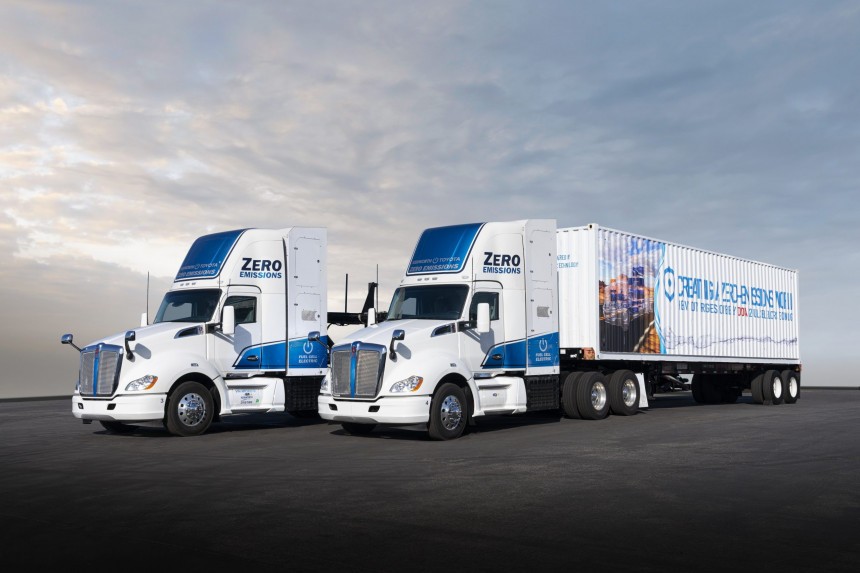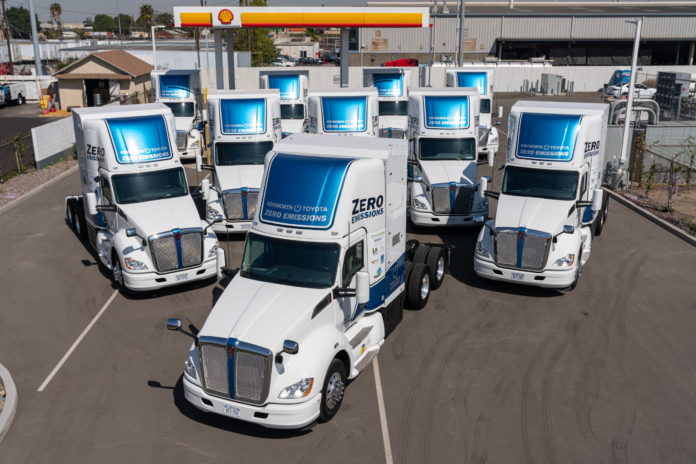Photo: Toyota USA-Kenworth
Under normal circumstances, this truck would sport a 12.9-liter PACCAR MX-13 straight-six engine jetting in the neighborhood of 450 horsepower and between 1,500 and 1,850 lb-ft (2033.7-2508.2 N-m) of torque alongside a 12-speed, semi-automatic gearbox. The new T680E ditches all of that in favor of electric motors powered by hydrogen fuel cells. Dubbed “Project Ocean,” this new drivetrain reduces greenhouse gas emissions by 74.66 metric tons annually per truck. Multiply that by every big rig in America, and you can almost see a thick film of smog over the Continental U.S. begin dissipating.
Kenworth-Toyota claims this Hydrogen-EV truck can crank 670 peak horsepower and an eye-watering 1,623 lb-ft (2205.9) of torque. Moreover, it can haul a load of 82,000 lbs (37,194.5 kg) for a distance between 400 to 500 miles (643.7 to 804.6-km) with a single load of fuel. Needless to say, this has the potential to revolutionize American intermodal freight trucking. Doing so in a way not seen since the Scottish immigrant to Cleveland, Ohio turned Bicycle maker Alexander Winton invented the first semi-truck in the late 19th century.
If this is indeed the case, it all starts with trial runs hauling freight for the Port of Los Angeles, the busiest cargo seaport in North America and one of the largest in the world. “Collaborating with original equipment manufacturers like Toyota and Kenworth on this demonstration project is an important step toward bringing next-generation technologies to market,” said Port of Los Angeles Executive Director Gene Seroka. “We’re grateful to CARB for its generous grant to support this effort and look forward to additional zero-emission vehicles operating at the Port of Los Angeles.”

Photo: Toyota USA-Kenworth
Meanwhile, the Shell Oil Company’s American subsidiary is playing a vital role in the ZANZEFF project in its own right. Supplying a steady stream of cryogenically-chilled hydrogen for Toyota-Kenworth’s fleet of Port of LA EV trucks. “Shell anticipates a great use-case for hydrogen in Commercial Road Transport here in California, and the success of the ZANZEFF project has been an important step in achieving commercialization,” said Wayne Leighty, Shell Hydrogen Mobility, Commercial Head, North America.
“Collaborations across both the private and public sectors is key to advancing zero-emissions heavy-duty mobility, and we are grateful to CARB, Port of Los Angeles, and ZANZEFF members for their support.” If successful, full-scale production of the fuel-cell powertrains designed for Kenworth trucks will begin at the Toyota Motor Manufacturing facility in Kentucky beginning next year. In the meantime, Port of LA truckers will put these rigs through their paces the same as they would a tried and true Cummins diesel.
Unlike said Cummins, these trucks produce zero greenhouse gasses while giving a performance that, at least on paper, matches that of diesel engines to a stunning degree. If you can’t stand the sight of a smelly, obnoxiously loud diesel semi-truck, these are bound to, at minimum, be slightly more tolerable.

